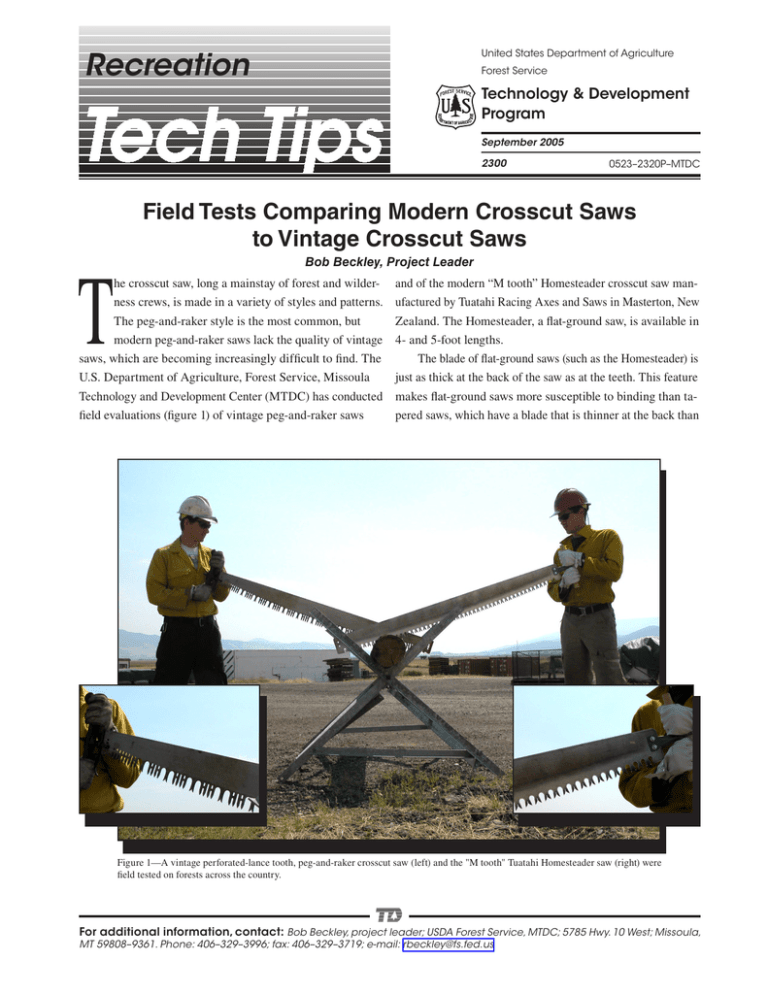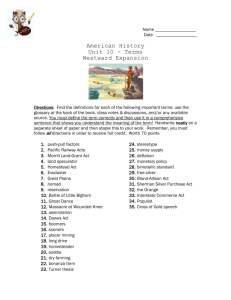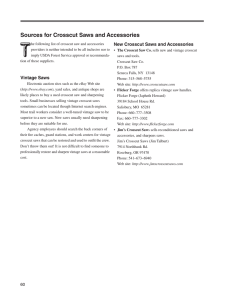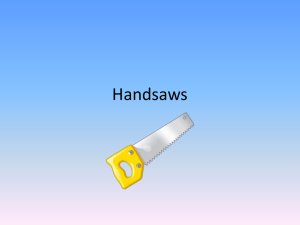T Recreation Field Tests Comparing Modern Crosscut Saws to Vintage Crosscut Saws
advertisement

Recreation United States Department of Agriculture Forest Service Technology & Development Program September 2005 2300 0523–2320P–MTDC Field Tests Comparing Modern Crosscut Saws to Vintage Crosscut Saws T Bob Beckley, Project Leader he crosscut saw, long a mainstay of forest and wilderness crews, is made in a variety of styles and patterns. The peg-and-raker style is the most common, but modern peg-and-raker saws lack the quality of vintage and of the modern “M tooth” Homesteader crosscut saw manufactured by Tuatahi Racing Axes and Saws in Masterton, New Zealand. The Homesteader, a flat-ground saw, is available in 4- and 5-foot lengths. saws, which are becoming increasingly difficult to find. The The blade of flat-ground saws (such as the Homesteader) is U.S. Department of Agriculture, Forest Service, Missoula just as thick at the back of the saw as at the teeth. This feature Technology and Development Center (MTDC) has conducted makes flat-ground saws more susceptible to binding than tafield evaluations (figure 1) of vintage peg-and-raker saws pered saws, which have a blade that is thinner at the back than Figure 1—A vintage perforated-lance tooth, peg-and-raker crosscut saw (left) and the "M tooth" Tuatahi Homesteader saw (right) were field tested on forests across the country. For additional information, contact: Bob Beckley, project leader; USDA Forest Service, MTDC; 5785 Hwy. 10 West; Missoula, MT 59808–9361. Phone: 406–329–3996; fax: 406–329–3719; e-mail: rbeckley@fs.fed.us 1 at the teeth. Peg-and-raker saws have two or four pegs separated by a raker (figure 2). Pegs (cutting teeth) sever the wood fiber and rakers remove the cut material. The Homesteader’s “M tooth” pattern doesn’t have rakers and is built on a competition racing saw design (figure 3). TOOTH PATTERNS Champion Figure 3—The "M tooth" pattern on a modern Tuatahi Homesteader crosscut saw. Lance Perforated lance Figure 2—Three of the most popular tooth patterns used in vintage peg-and-raker crosscut saws: the champion, lance, and perforated lance. Vintage peg-and-raker saws were field tested alongside the Homesteader "M tooth" saw across the country. Experienced, certified crosscut saw sawyers used both saws to cut a variety of trees. All sawyers felt that the Homesteader was an aggressive, fast-cutting saw. The Homesteader’s blade has very little arc compared to the blade of a traditional peg-and-raker saw. Because the saw has very little arc and no rakers, more teeth are in the wood at any given time than for a vintage peg-andraker crosscut saw. The Homesteader saw cut well in dry wood, but tended to bog down or bind in green or wet wood. This binding could be partly because the Homesteader saw is flat ground, which increases drag and friction in the cut, and partly because the Homesteader does not have rakers and just has small gullets to move wood shavings out of the cut (figures 4 and 5). The Homesteader is thicker and heavier than vintage pegand-raker saws of the same length. While the weight of the becoming cut saws are ss ro c e g ta • Vin find. ut saws difficult to oth” crossc to M “ tion. rn e • Mod for competi d e n g si e d ed to are when allow commonly , rs e y w sa s side rvice • Forest Se rosscut saw c e g ta in v and intage test modern ferred the v re p y ll a su u by side, ws. crosscut sa Figure 4—Wood shavings from the Tuatahi crosscut saw are short. 2 Figure 5—The shavings from a peg-and-raker crosscut saw are much longer. Homesteader saw is a drawback for crews who carry their saws to the jobsite, the added weight and the thickness of its blade enables the Homesteader to make nice, straight cuts. The "M tooth" design allowed sawyers to start their cuts easily. The stiffness made the Homesteader a good one-person bucking saw. The saw’s stiffness and the ease of starting a cut with the Homesteader make it an excellent training saw for new sawyers. A tooth broke off one of the Homesteader crosscut saws when a log that was being underbucked (cut from below) fell on it (figure 6). This problem raised some concerns about the quality and tempering of the metal used in the blade. The supplier and the saw’s manufacturer said this problem had not occurred before and promptly replaced the saw with a new one. Figure 6—A tooth broke on the Tuatahi Homesteader saw when a log fell on it. The manufacturer and the U.S. supplier say this problem has not occurred before. When the Homesteader was used as a felling saw, its stiffness enabled sawyers to make the starting cut easily and to make cuts that were level. The saw’s depth (height from the saw’s back to its teeth) hindered the use of wedges. The saw’s flat-ground design and the inability to use wedges properly increased binding. Because the Homesteader has no flex, it must be packed straight along the side of a horse or mule. The saw cannot be bent and tied around a pack, as can vintage peg-and-raker saws. Both saws must be sheathed or placed in a scabbard when being packed. The Homesteader saw was easier for sawyers to carry over their shoulders because its short, stiff blade eliminated most of the bounce that can make the vintage pegand-raker saws uncomfortable to carry. The "M tooth" Homesteader crosscut saw performed very well in a variety of situations, but most sawyers preferred vintage peg-and-raker crosscut saws. Sawyers felt that the Homesteader forced them to cut faster than usual, tiring them quickly. Sawyers felt that vintage peg-and-raker saws allowed them to develop a sawing rhythm so they could cut longer without tiring. The small gullets on the Homesteader crosscut saw didn’t load and unload cut material as readily as did the gullets on a peg-and-raker saw, particularly when the wood was wet or green. The Homesteader crosscut saw is available only in 4- and 5-foot lengths, which limit its usefulness for cutting large trees. This tech tip reflects the results of limited testing. It is intended to identify options rather than to offer recommendations on the type of crosscut saw to purchase. Vintage peg-andraker crosscut saws and the Tuatahi Homesteader saw both performed well in testing. Bailey’s (707–984–6133, http://www.baileys-online.com) is the U.S. supplier for the Tuatahi Homesteader crosscut saw. U.S. Department of Agriculture, Forest Service employees, contractors, and volunteers who operate a crosscut or chain saw must have completed the required training and be certified for the types of saw work they will be performing. Contact your local Forest Service saw coordinator for training information. Additional crosscut saw publications are available from MTDC. They include: Crosscut Saw Manual (7771–2508– MTDC), Saws That Sing: A Guide to Using Crosscut Saws (0423–2822–MTDC), and New Tools for Old Saws: Crosscut Saw Tools (0523–2815–MTDC). 3 About the Author to the Missoula Technology and Development Center in Bob Beckley received a bachelor’s degree in political science from the University of Montana in 1982. He began his 1990. He works as a project leader and is the center’s public Forest Service career as a timber technician on the Nez Perce and governmental relations specialist. National Forest. Beckley was a smokejumper when he came Library Card Beckley, Bob. 2005. Field tests compare modern to vintage (measured from the back of the saw’s blade to its teeth) than crosscut saws. Tech Tip 0523–2320P–MTDC. Missoula, a traditional saw, which makes it harder to use wedges when MT: U.S. Department of Agriculture, Forest Service, felling a tree. The Homesteader doesn’t have rakers to remove Missoula Technology and Development Center. 4 p. wood shavings, which means more cutting teeth are in the Describes field tests by experienced, certified crosscut wood at any time, allowing the Homesteader to cut more sawyers comparing the modern Homesteader crosscut saw manufactured by Tuatahi Racing Axes and Saws in New Zealand to vintage peg-and-raker crosscut saws. The Homesteader is shorter and stiffer than vintage crosscut saws, which offered some advantages. The Homesteader is flat ground (the back of the saw’s blade is as thick as the teeth), rather than tapered (the back of the saw’s blade is thinner than the teeth), which makes the Homesteader crosscut saw more likely to bind in a cut. In addition, the Homesteader is deeper quickly than a traditional crosscut saw. Although the Homesteader crosscut saw performed well in a variety of situations, most U.S. Department of Agriculture, Forest Service sawyers preferred vintage peg-and-raker crosscut saws, because they allowed sawyers to develop a sawing rhythm and work longer before tiring. Keywords: Homesteader, tools, traditional tools, Tuatahi Racing Axes and Saws Single copies of this document may be ordered from: USDA Forest Service, MTDC 5785 Hwy. 10 West Missoula, MT 59808–9361 Phone: 406–329–3978 Fax: 406–329–3719 E-mail: wo_mtdc_pubs@fs.fed.us For further technical information, contact Bob Beckley at MTDC. Phone: 406–329–3996 Fax: 406–329–3719 E-mail: rbeckley@fs.fed.us Electronic copies of MTDC’s documents are available on the Internet at: http://www.fs.fed.us/t-d/ (Username: t-d, Password: t-d) The U.S. Department of Agriculture (USDA) prohibits discrimination in all its programs and activities on the basis of race, color, national origin, age, disability, and where applicable, sex, marital status, familial status, parental status, religion, sexual orientation, genetic information, political beliefs, reprisal, or because all or part of an individual’s income is derived from any public assistance program. (Not all prohibited bases apply to all programs.) Persons with disabilities 4 Forest Service and Bureau of Land Management employees can search a more complete collection of MTDC’s documents, videos, and CDs on their internal computer network at: http://fsweb.mtdc.wo.fs.fed.us/search who require alternative means for communication of program information (Braille, large print, audiotape, etc.) should contact USDA’s TARGET Center at (202) 720-2600 (voice and TDD). To file a complaint of discrimination, write to USDA, Director, Office of Civil Rights, 1400 Independence Avenue, S.W., Washington, D.C. 20250-9410, or call (800) 795-3272 (voice) or (202) 720-6382 (TDD). USDA is an equal opportunity provider and employer.



